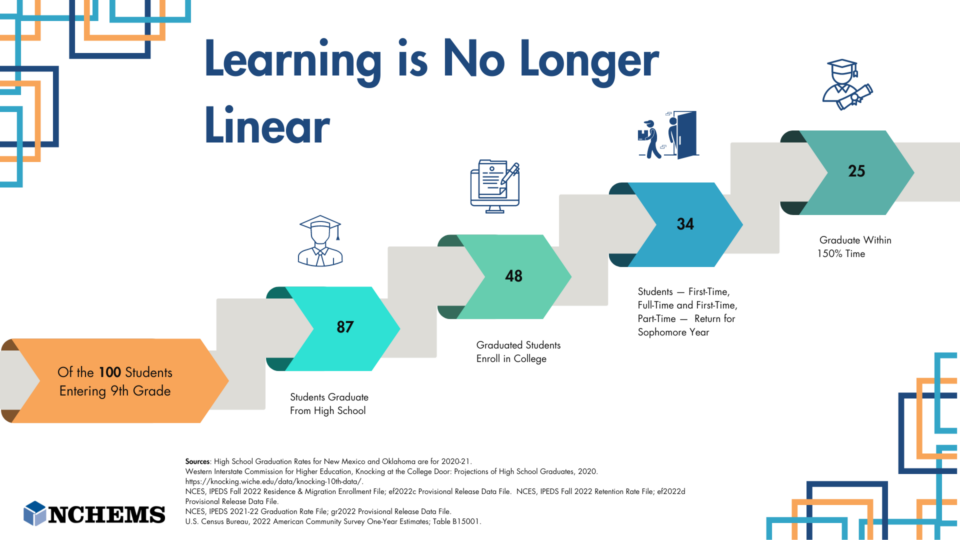While this seems like a relatively straightforward question, it is currently impossible to pinpoint this number. This is because there is no national, student-level data system that captures individuals’ educational experiences as they progress through high school and enter postsecondary education.
Over two decades ago, the National Center for Higher Education Management Systems (NCHEMS) created a way to approximate how many students successfully navigate their educational journeys through high school and beyond — it’s not perfect. But it helps conceptualize the scope of the challenges students face nationally and in the states. (Learn more about this process below.) It has been particularly impactful in benchmarking states’ performance against one another so that individual states can better understand students’ educational journeys.
The results were sobering. In 2018, NCHEMS found that for every 100 students entering ninth grade, only 18 would complete a postsecondary credential on time. NCHEMS measures “on time” completion within 150% of normal program time. This means six years for bachelor’s degrees, three years for associate’s degrees, and 1.5 years for one-year certificates. From 2018 to 2022, a drop in college-going rates nationally contributed to a 1.4% decrease in the estimated number of people continuously persisting from high school graduation to postsecondary credential completion. This drop is moving the nation further away from increasing educational attainment.

NCHEMS’ refreshed analysis for the United States with an updated visualization of the data.
As the NCHEMS team approaches a refresh of this analysis, we do so with a renewed sense of both its strengths and limitations. As a field, we must study the most direct path to educational attainment and work on smoothing transitional points, especially for students who have been historically marginalized from the educational system. But we also must recognize the pipeline fails to be an appropriate metaphor for a growing number of students whose educational journeys look much different. Learning happens in new ways, at different times and across an individual’s entire career, not only in high school and not only in colleges and universities.
We therefore must do more to ensure that when validated learning occurs — whether it accrues postsecondary credit or not — it leads to good job opportunities that also have a high impact on meeting workforce needs. This is why improving data collection on noncredit credentials will not only increase the accuracy with which we can measure educational attainment but also support our collective learning about what works — and what doesn’t. New work from Chris Mullin, through the National Postsecondary Education Cooperative (NPEC), provides a historical perspective and recommendations on how data collection can be approached and improved.
Together with improvements in measurement, our educational systems — designed first and foremost to serve students — must also do more to ensure student success. For students who enroll in college immediately after high school, institutions must do everything they can to support the continuity of that experience. National data lay bare that the first time a student enters college is the most likely time that they will persist through to graduation. As the nation’s population of students with some credits and no credential continues to grow, systems must change to better serve students all along their educational journey.
Doing this will likely require further disaggregation of data that is not currently possible to estimate at a national or state level. To do this, institutions and states will need to work together to align on which students the system is serving well, and which students the system must work to serve better.
Much has changed over the decades that NCHEMS has estimated the number of on-time credential completers based on high school graduates. Though there are methodological drawbacks to estimating cohorts where actual cohorts do not exist, we believe that this data can support productive conversations across various stakeholders ranging from K-12 school and district leaders to postsecondary system and institutional leaders to policymakers. If you are interested in receiving an estimate of how linear educational journeys are in your state, please fill out this form below and our team will be in touch.
For each state and the U.S., the pipeline measures the estimated number of ninth-grade enrollments (per 100) expected to progress along the secondary and postsecondary education pipeline and who ultimately receive a postsecondary certificate or degree.
The data that feed into the pipeline are all publicly available. Most of the metrics used to produce the pipeline are data aggregated from the National Center for Education Statistics (NCES) Integrated Postsecondary Education Data System (IPEDS) . Public high school graduation rates by state are published by NCES, but the other metrics that feed into the pipeline are aggregated from institution-level data pulled from IPEDS and aggregated to the state level for all Title IV degree-granting institutions. High school graduate numbers used in the calculation for college-going rates are drawn from the Western Interstate Commission for Higher Education (WICHE) high school graduate projections .
The National Center for Higher Education Management Systems (NCHEMS) can produce a student pipeline for any state requested. Please submit this form to request a specific state's version of the student pipeline. You can view the student pipeline for the United States on the NCHEMS website.